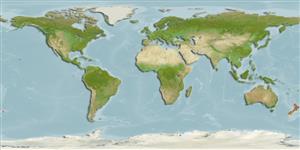分類 / Names
俗名 | 同種異名 | Catalog of Fishes(屬, 種) | ITIS | CoL | WoRMS | Cloffa
Teleostei >
Ovalentaria/misc (Various families in series Ovalentaria)
鱸形目 (Various families in series Ovalentaria) >
Plesiopidae (Roundheads)
鮗科 (Roundheads) > Acanthoclininae
Etymology: Acanthoclinus: Greek, akantha = thorn + Greek, klinein, kline = sloping and bed, due to the four apophyses of sphenoid bone (Ref. 45335).
Environment: milieu / climate zone / depth range / distribution range
生態學
海洋 居於水底的; 非遷移的; 深度上下限 0 - 80 m (Ref. 9003). 溫帶
Southwest Pacific: endemic to New Zealand.
西南太平洋: 紐西蘭的特有種。
大小 / 重量 / 年齡
Maturity: Lm ? range ? - ? cm
Max length : 11.5 cm TL 雄魚/尚未辨別雌雄; (Ref. 9003)
簡短描述
檢索表 | 型態特徵 | 形態測量圖
背棘 (總數) : 12 - 14; 背的軟條 (總數) : 3 - 4; 臀棘: 14 - 15; 臀鰭軟條: 3 - 4. Head and body uniformly brown with a darker blotch on the gill cover. Forehead with a pale stripe. Dorsal and anal fins with orange tips. Distinguished from other rockfishes by its small size, undivided lower lateral line and the single pair of pores on the chin.
頭部與身體全身褐色的在鰓蓋上具有一個較深色的斑塊。 前額具有一個灰白的斑紋。 背鰭與臀鰭有橘色的頂端。 在下巴上用它的體型小, 未分開的低側線與單一成對的孔與其他的礁石魚類區分了。
Adults occur in the subtidal zone but may be found in rock pools at low tide (Ref. 9003). Eggs are guarded by the male parent (Ref. 205).
出現於亞潮間帶的區域在低潮的岩石區潮池中但是可能被發現。
Life cycle and mating behavior
Maturities | 繁殖 | Spawnings | Egg(s) | Fecundities | 仔魚
Eggs are guarded by the male parent (Ref. 205).西南太平洋: 紐西蘭的特有種。
Paulin, C. and C. Roberts, 1992. The rockpool fishes of New Zealand (Te ika aaria o Aotearoa). Museum of New Zealand (Te Papa Tongarewa). 177 p. (Ref. 9003)
人類使用
漁業: 沒有興趣
工具
特別的報告
下載 XML
網路資源
Estimates based on models
Phylogenetic diversity index (Ref.
82804): PD
50 = 0.5312 [Uniqueness, from 0.5 = low to 2.0 = high].
Bayesian length-weight: a=0.00457 (0.00180 - 0.01158), b=3.10 (2.87 - 3.33), in cm total length, based on LWR estimates for this (Sub)family-body shape (Ref.
93245).
營養階層 (Ref.
69278): 3.4 ±0.6 se; based on size and trophs of closest relatives
回復力 (Ref.
120179): 高度, 族群倍增時間少於 15個月 (Preliminary K or Fecundity.).
Fishing Vulnerability (Ref.
59153): Low vulnerability (10 of 100).
